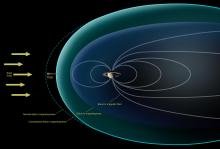Listen to today's episode of StarDate on the web the same day it airs in high-quality streaming audio without any extra ads or announcements. Choose a $8 one-month pass, or listen every day for a year for just $30.
You are here
Moon and Saturn
Saturn is made almost entirely of hydrogen and helium — the same ingredients that make up the Sun. But like an apple, it’s topped by a thin “skin” — in this case, layers of clouds that contain water, ammonia, and other ingredients. They’re a few hundred miles deep. But compared to Saturn’s diameter of 72,000 miles, that’s not much.
As you plunge into those layers, the temperature changes dramatically. At the top of the clouds, it averages about minus-275 degrees Fahrenheit. The temperature actually drops a bit below that altitude because the top of the atmosphere absorbs a little of the Sun’s energy.
At a pressure of one bar — the equivalent of the surface pressure on Earth — the temperature jumps to about minus-220. By comparison, on Earth the surface temperature is about 60 degrees.
Clouds made of water ice start below that level and extend for scores of miles. At the bottom of that layer, the atmosphere has warmed up to almost freezing.
Finally, the lower layer, made of water and ammonia, goes much deeper. The temperature at the bottom of that layer may reach 135 degrees.
And thanks to the pressure inside Saturn, plus a possible “rain” of helium drops, the temperature keeps going up until you reach the center — a toasty 21 thousand degrees.
Saturn stands close to the upper right of the Moon as night falls. It looks like a bright star — thanks in part to its cold, cold clouds.
Script by Damond Benningfield





